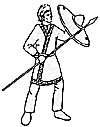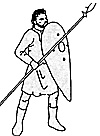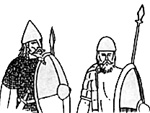 Wargaming is a type of game that allows you and your friends to play the part of military
commanders in a battle. Your army is composed of toy soldier divided into units. Game rules
describe how to move across the battlefield and fight. As the army commander, your job is to
maneuver your army to outsmart your opponent and win the battle.
Wargaming is a type of game that allows you and your friends to play the part of military
commanders in a battle. Your army is composed of toy soldier divided into units. Game rules
describe how to move across the battlefield and fight. As the army commander, your job is to
maneuver your army to outsmart your opponent and win the battle.
You can wargarne in any period of history that interests you. Today's battle is between Vikings and English, but rules and rriiniature soldiers are also available for Civil War, American Revolution, or any other time period. Famous people who had wargaming for their hobby include the authors H.G. Wells and Robert Louis Stevenson, and leaders like Winston Churchill and King Louis XIV of France. Large numbers of toy soldiers have been found in the tombs of ancient Egyptian and Chinese rulers, so it seems that wargaming is almost as old as civilization.
 In today's game we will use very simple rules to introduce the idea of wargaming. If you
take up this hobby you can get into more detailed sets of game rules if you want to. If you
enjoy wargaming there are related activities that you might also enjoy. Some people enjoy
painting the toy soldiers to make them as realistic looking as possible. You might want to read
about the actual battles to get ideas for your games. You might join a re-enactment society
whose members equip and organize themselves like soldiers from history and fight mock
battles for audiences. This can be a great hobby to get into with your parents.
In today's game we will use very simple rules to introduce the idea of wargaming. If you
take up this hobby you can get into more detailed sets of game rules if you want to. If you
enjoy wargaming there are related activities that you might also enjoy. Some people enjoy
painting the toy soldiers to make them as realistic looking as possible. You might want to read
about the actual battles to get ideas for your games. You might join a re-enactment society
whose members equip and organize themselves like soldiers from history and fight mock
battles for audiences. This can be a great hobby to get into with your parents.
Toy soldiers that are suitable for wargarning can be purchased through the mail, over the internet, or at some hobby shops. Locally the best (and most expensive) figures are available for purchase at Crazy Egor's hobby shop on West Henrietta Rd. Less expensive plastic figures can often be found at hobby shops specializing in crafts or model railroad accessories. You can even play using rectangular blocks of wood to represent units of soldiers, although that lacks visual appeal.
Internet site of interest to wargamers:
http://www.ftech.net/~regia/regblurb.htrn. This will connect you to a fun website that tells all about the period of history represented in today's game.
Rules for the Battle of Ashdown
Saxons vs Vikings 871 A.D.
Movement
To keep things simple, the opposing armies do not move at the same time. At the start of each game turn the Saxons and Viking kings will each roll a dice. Whichever king rolls higher can choose to move first or second in that turn. Note that this can lead to one army moving last in one turn and first in the next turn, which can be an advantage.
Each player starts the game with 3 warbands. When it's your army's turn to move, each commander rolls 1 dice. The dice are modified to read just 1, 2, or 3. Subtract 1 for each warband destroyed in a previous turn. The number left is the number of warbands you can move that turn.
For each warband you are moving, throw 4 dice and move up to that number of inches. Move each warband in any direction as long as no corner of the tray that holds the figures goes farther than the maximum allowed distance.
Berserkers cause movement problems for the vikings. In each command that has berserks, that warband must move before any other, it must move it's full distance, and it must move directly toward the nearest enemy.
If within 6" of the front of an enemy warband, you can only contact it by the shortest route.
Combat
To attack an enemy warband, move into contact with it. If any part of your band touches the enemy band (except corner to corner), then line them up squarely. A band that is contacted to flank or rear, and not in combat to its front, can turn to face its attackers. When all movement is completed, the attacking player decided the order that the combats are resolved.
When two warbands fight, the opposing players each roll one die and add modifiers. If the modified rolls are equal, nothing happens and they remain in contact until the next turn, when they fight again. If one side's score is higher than that of the other but not twice as high, then the loser is pushed straight back 4 inches. The winner can either follow up and remain in contact or not, his choice.
If one side's score is double the other then the loser is destroyed. If more than one warband attacks one enemy band, only 1 conbat is fought and the additinoal warband provides combat modifiers. If a losing warband would be pushed back but has enemy in contact to flank or rear, it is destroyed instead. If a band is pushed back into an enemy it is destroyed. If it is pushed back on a friendly, it pushes the otber band back the necessary distance to make room.
Combat Modifiers
-
+1 Viking Huscarls and Berserkers, or Saxon Hearthweru
+1 If opponent moved uphill or you moved downhill into contact this turn.
-1 for each overlap
-1 if demoralized
Morale
Each player has a command of 3 bands. When 2 have been destroyed, the command is demoralized. Demoralized bands cannot initiate combat and must move at double speed towards the nearest table edge (except the one the enemy started from). When half the warbands of an entire army are either destroyed or demoralized, that army flees and the game is over.
Berserkers are an exception to tbe morale rules. Tbey never become demoralized.
Being attacked by Berserkers causes a special morale problem. If a berserker tries to contact a Saxon band that is not hearthweru, the Saxons roll a dice. If they get a 6, the band is temporarily demoralized and takes one double move away from the berserks. If they reach a table edge, tbey are removed from the game. If they are already in combat with enemy and they have to flee, they are destroyed instead.
Turn Sequense
1) Saxon and Viking eacb roll 1 dice. High roll choses to move first or second that turn.
2) On the side that moves first, each player rolls 1 die. That minus the number of warbands lost = bands to move.
3) For such warbands to be moved, roll 4 dice. Each player completes the movement of one warband before rolling for the next.
4) When all movement is complete, do combats. That ends one side's half of the turn.
5) The side that did not yet move in the current turn now does steps 2, 3, and 4. That ends 1 complete turn. Check the morale condition of the individual command and the two armies and then start over with step 1.
What Was Battle Like?
The opposing armies would assemble in front of their camps at dawn. Each Leader would display his personal banner where the army commander told him to be, so his men would know where to stand in line.
The Christian Saxons would kneel and teceive blessings from clergy that always traveled with the army. The Vikings at this time were not yet Christians, but they had their own religious rites that they thought would bring them luck in battle.
When they were ready to begin, the army commanders would have tbeir trumpeters sound the advance. Each side tried to keep its front ranks close together by walking slowly toward the enemy. At this time, Vikings and Saxons were all foot soldiers. The men would be close enough for the edges of their shields to touch. The line might be anything from 3 to 10 ranks deep, depending on the numbers present and the room on the battlefield. Because ground is usually not flat and level, and the men weren't well drilled, the front of each army usually became uneven long before the line clashed. When within one hundred yards or so of each other, they would begin to chant and clash their weapons on the inside of their shields. They did this to keep staying close together, to overcome the fear they were really feeling, and to try and frighten the enemy. When they were about forty yards apart, the Saxons would shout their warcry that included God and the king, and sometimes simply 'Out! Out!'. The Vikings would shout their chilling warcry to Odin, their god of battle, and then the two lines would close the distance at a run.
 Just before the lines met, they would hit each other with a shower of thrown spears, light
axes, and even rocks. When they collided the wooden shields of the front ranks banging
together made a loud noise. A few men were knocked right off their feet. The rest would begin
trying to strike their opponent over, under, around, or through the shield. The sounds of metal striking metal or wood, mixed with the shouts of angry, frightened or wounded men were
something that those who were there remembered the rest of their lives. Before too long, the
bravest men would start forcing their way into the opposing wall of shields and the formations
would start to break up. The side that was most broken up would start to sense that they were
losing. First a few men would run away, and then more. Finally, evan the bravest would see
that they had no chance and everyone would run to try and save themselves. Most of the
winners would be so relieved to find themselves alive, and so physically exhausted by the fight
that they wouldn't chase the losers very far. Most battles at this time were over within an hour of the first clash.
Just before the lines met, they would hit each other with a shower of thrown spears, light
axes, and even rocks. When they collided the wooden shields of the front ranks banging
together made a loud noise. A few men were knocked right off their feet. The rest would begin
trying to strike their opponent over, under, around, or through the shield. The sounds of metal striking metal or wood, mixed with the shouts of angry, frightened or wounded men were
something that those who were there remembered the rest of their lives. Before too long, the
bravest men would start forcing their way into the opposing wall of shields and the formations
would start to break up. The side that was most broken up would start to sense that they were
losing. First a few men would run away, and then more. Finally, evan the bravest would see
that they had no chance and everyone would run to try and save themselves. Most of the
winners would be so relieved to find themselves alive, and so physically exhausted by the fight
that they wouldn't chase the losers very far. Most battles at this time were over within an hour of the first clash.
The Saxons
The Saxons at the battle were the men of Wessex (which means 'West Saxons'). Wessex was one of several kingdoms in England at this time The second in command of the Saxon army at the battle, and the person responsible for the Saxon victory was tbe younger brother of tbe king of Wessex. His name was Alfred, and he wasn't much older than the people playing this game. When his brother died, Alfred became king of Wessex, went on to save England from the Vikings, and is remembered in history as Alfred the Great. He also established the first schools in England, so when your alarm clock goes off on Monday mornings you will know who to thank.
Saxon armies at this time were composed of two types of troops, Hearthweru and Fryd. The Hearthweru were the bodyguards of the nobles who ruled the country. They were professional soldiers and wore a helmet and chainmail shirt, and were armed with svord, shield and spear. If the leader they were sworn to potect fell in battle, they would sometimes surround him and fight to the end rather than run away. The Fryd were militia composed of free men. They were normally farmers but when the country was attacked, they would follow their local noble to war. At the end of the war they would return to their farms. They were usually less well equipped and less experienced than tbe bodyguards.
The Vikings
The Viking army at the battle of Ashdown was actually two armies that had combined to conquer Wessex. One, called the 'Great Army', was led by the sons of Ragnar. They had come to Englnd a fee years before to avenge their father's execution by theking od one of the other English kingdoms. They got even in a way that's too disgusting for me to repeat, so you will have to look it up yourself. After that they stayed to plunder the rest of tbe kingdoms in England.
The other was called the 'Summer Army', and was commanded by a Viking named Bagsac. Most of the men in both armies were from Denmark, but they were not there fighting for their country. They were all volunteers who had joined one of the leaders for plunder, the chance of winning land,and to buld a reputation as a brave warrior--highly valued in their society.
Viking armies at this time were composed of three types of troops, Huscarls, Drengs, ar d Berserks. Huscarls were the bodyguards of the Viking kings, and were similar to the Saxon Hearthweru. They often were armed with a big axe in addition to equipment like that of their Saxon counterparts. Drengs were ordinary Vikings. They were often farmers who would plant their crops in the spring, go off to join one of the armies in plundering their neighbor, and then return home in the autumn to harvest the crops. They were equipped in the same way as the Saxon Fryd. Berzerkers are the most interesting. They believed that the spitits of wolves or bears took over their body when they entered battle. They dressed in the skins of wolves and bears and howled like wild animals they charged. To prove their fearlessness they often threw away their shields and refused to wear armor. The modern werewolf legends are based on old stories about the berserkers.
Corrupting the Youth of America
Back to Saga #64 Table of Contents
Back to Saga List of Issues
Back to MagWeb Master Magazine List
© Copyright 1998 by Terry Gore
This article appears in MagWeb (Magazine Web) on the Internet World Wide Web. Other military history articles and gaming articles are available at http://www.magweb.com